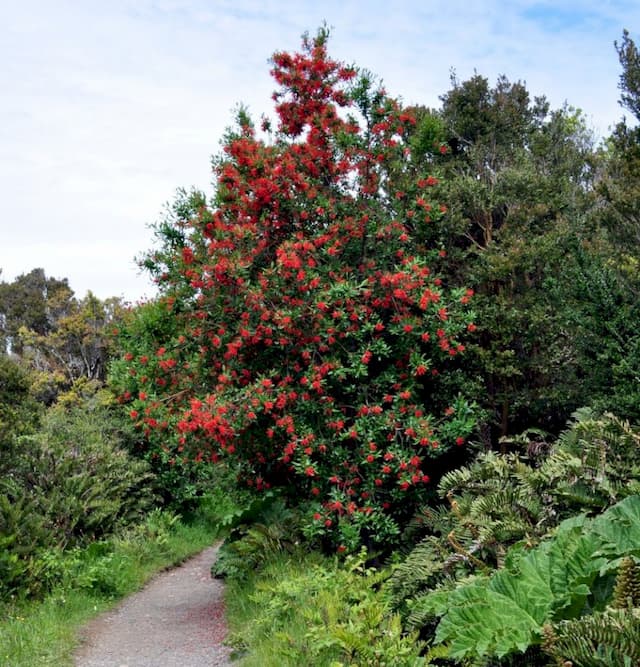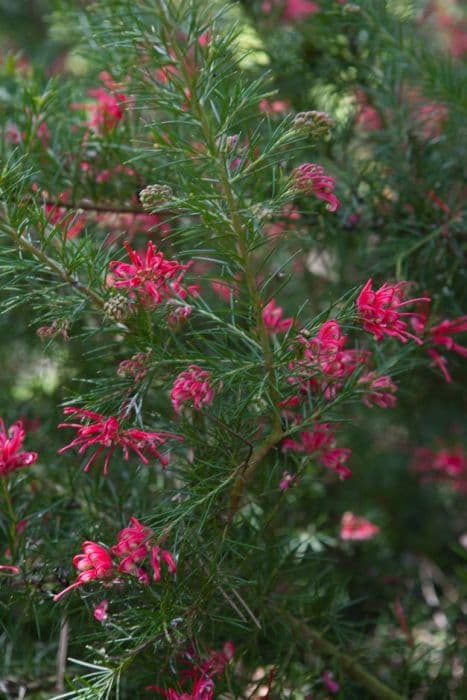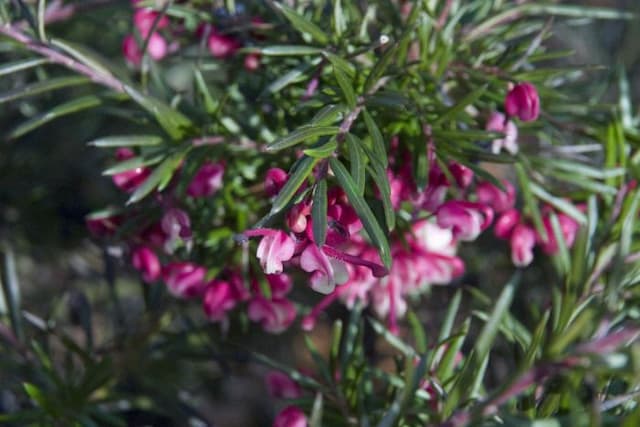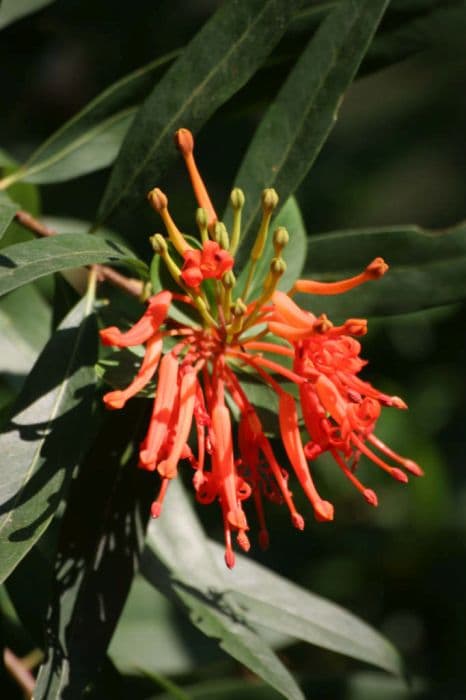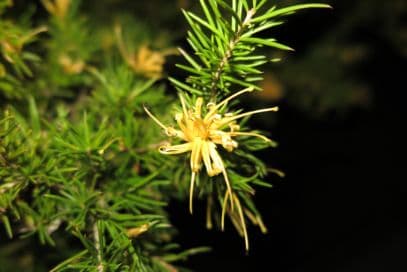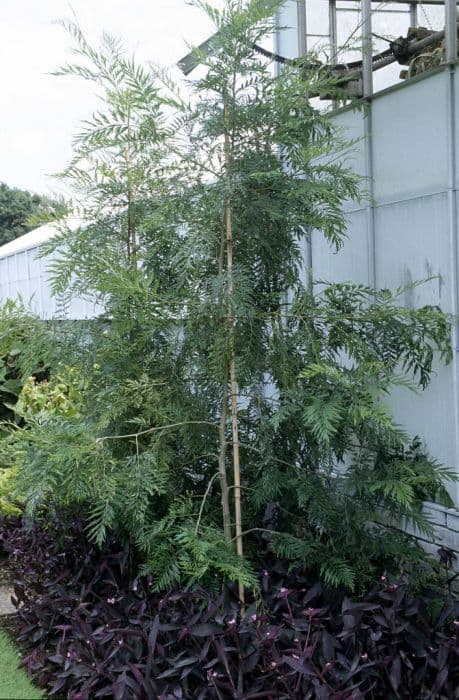Silver Banksia Banksia marginata

ABOUT
Banksia marginata, commonly known as the silver banksia, displays a range of appearances due to its adaptability but generally possesses certain identifiable characteristics. The leaves of the silver banksia are narrow and oblong, usually displaying a dark green color on the upper surface and a paler tone underneath. The edges may be smooth or serrated, often with a silver-white underside, contributing to its common name. The distinctive flowers of the silver banksia form cylindrical spikes with hues ranging from pale yellow to golden, and they often emerge during late summer and autumn. Each flower spike consists of many small flowers densely packed together. These spikes, once spent, morph into intriguing cone-like structures with follicles that hold the seeds. The bark of the silver banksia is another notable feature, typically rough and textured, varying from grey to brown in color. It provides a stark contrast to the foliage and the bright colors of the blooms. The appearance of the plant can vary significantly across different environments, but these key features are typically present in the diverse forms of the silver banksia.
About this plant
 Names
NamesSynonyms
Silver Banksia, Honeysuckle Oak, Dwarf Honeysuckle, Minyura, Wirilda
Common names
Banksia australis, Banksia integrifolia, Banksia latifolia, Banksia littoralis, Banksia patula, Banksia robusta, Banksia verticillata, Isostylis marginata, Sirmuellera marginata, Sirmuellera terraereginae.
 Toxicity
ToxicityTo humans
Banksia marginata, commonly known as the Silver Banksia, is not generally considered toxic to humans. There is no widespread evidence of poisoning from ingestion of parts of the Silver Banksia, and it is not commonly listed among plants that are harmful when consumed. However, as with any plant not intended for human consumption, individual reactions can vary, and it is always wise to be cautious and avoid ingesting plant material that is not known to be safe or is not typically used as food.
To pets
Silver Banksia is not generally recognized as toxic to pets either. There are no well-documented cases of poisoning in pets such as dogs and cats from ingesting this plant. Nevertheless, individual animals may have sensitivities or allergic reactions to plants that are not typically toxic, so it is still prudent to prevent pets from consuming parts of the Silver Banksia or any other ornamental plants not specifically known to be safe for them. If a pet does ingest some of it and exhibits signs of distress or illness, it is advisable to consult a veterinarian.
 Characteristics
CharacteristicsLife cycle
Perennials
Foliage type
Evergreen
Color of leaves
Green
Flower color
Yellow
Height
6-25 feet (1.8-7.6 meters)
Spread
6-8 feet (1.8-2.4 meters)
Plant type
Shrub
Hardiness zones
9
Native area
Australia
Benefits
 General Benefits
General Benefits- Wildlife Habitat: Banksia marginata provides food and shelter for a variety of birds, insects, and small mammals, due to its nectar-rich flowers and dense foliage.
- Soil Erosion Control: Its extensive root system can help stabilize soil and prevent erosion, particularly in coastal and sandy environments.
- Ornamental Value: With its distinctive flowers and foliage, the Silver Banksia is popular in ornamental horticulture and is used in landscaping for aesthetic appeal.
- Cultural Significance: Indigenous Australians use the Silver Banksia for traditional purposes, such as using the nectar for sweet drinks and the wood for tools.
- Drought Tolerance: The Silver Banksia is adapted to survive in environments with low water availability, making it a suitable plant for drought-prone areas.
- Ecological Restoration: It can be used in revegetation projects to restore native habitats and ecosystems.
- Adaptability: The Silver Banksia shows adaptability to different soil types and environmental conditions, making it a versatile plant for various habitats.
- Seasonal Interest: It produces distinct seasonal changes, with flowering typically occurring in autumn and winter, offering aesthetic variety throughout the year.
 Medical Properties
Medical PropertiesThis plant is not used for medical purposes.
 Air-purifying Qualities
Air-purifying QualitiesThis plant is not specifically known for air purifying qualities.
 Other Uses
Other Uses- Banksia marginata timber is used for woodturning and craftwood; it is a popular species for amateur and professional woodworkers due to its interesting grain patterns.
- The Silver Banksia's dried flower heads are used in floral arrangements; the distinctive cone-like structures add a unique texture to bouquets and displays.
- Indigenous Australians traditionally used the Silver Banksia's nectar by soaking the flower heads in water to create a sweet drink.
- The bark of the Silver Banksia can be used in tanning to produce yellow or green dyes.
- Handicrafts and jewelry makers use the seed pods and dried flowers for creating natural and sustainable decorative items.
- Silver Banksia plays a crucial role in stabilizing soils and dune systems, preventing erosion along coastlines.
- The wood from Silver Banksia is sometimes utilized in making musical instruments, providing a unique Australian tone to specialty guitars and wind instruments.
- The plant's ability to grow in poor soil conditions makes it suitable for use in phytoremediation projects aimed at restoring degraded lands.
- Honey producers value Silver Banksia for its capacity to produce high-quality honey when used as a foraging plant for bees.
- Used in land reclamation, the Silver Banksia can be planted in areas with nutrient-deficient soils to improve soil quality over time.
Interesting Facts
 Feng Shui
Feng ShuiThe Silver Banksia is not used in Feng Shui practice.
 Zodiac Sign Compitability
Zodiac Sign CompitabilityThe Silver Banksia is not used in astrology practice.
 Plant Symbolism
Plant Symbolism- Resilience: Banksia marginata, commonly known as Silver Banksia, often thrives in poor soil conditions and can regenerate after bushfires, symbolizing the ability to endure challenging circumstances and recover from adversity.
- Longevity: The Silver Banksia has a long lifespan and displays ongoing growth, symbolizing longevity and the idea of enduring life or relationships.
- Protection: With its woody structure and ability to survive in harsh environments, the Silver Banksia can symbolize protection and the role of a guardian.
- Adaptability: As the Silver Banksia exhibits remarkable adaptability to different environments, it can symbolize the ability to adjust and thrive in various conditions or phases of life.
 Water
WaterThe Silver Banksia should be watered regularly during its growing season but allowed to dry out between waterings. It typically needs about 1 to 2 gallons of water every week during active growth, depending on the size of the plant and the weather conditions. In the winter months, water the plant less frequently, providing enough to prevent the soil from drying out completely. Since this plant is native to Australia and adapted to dry environments, over-watering can lead to root rot.
 Light
LightThe Silver Banksia thrives in full sun to partial shade. Place the plant in a spot where it can receive at least 6 to 8 hours of direct sunlight daily. Adequate light is essential for the plant to produce its characteristic flowers and to maintain healthy growth.
 Temperature
TemperatureSilver Banksia prefers a temperate climate with temperatures ranging from 50°F to 77°F. It tolerates minimum temperatures down to around 20°F; however, for optimal growth and bloom, temperatures should not frequently fall below freezing. The plant can withstand brief periods of higher temperatures, but prolonged exposure above 86°F may stress the plant.
 Pruning
PruningPruning the Silver Banksia is important to maintain its shape and to encourage new growth. Prune after flowering by cutting back the spent flower spikes and any unruly or dead branches. This is typically done in the late summer or early fall. Periodic thinning of the plant can also promote better air circulation and reduce the risk of fungal diseases.
 Cleaning
CleaningAs needed
 Soil
SoilThe best soil mix for Silver Banksia should be well-draining and sandy with some organic matter. It prefers slightly acidic to neutral pH levels, between 5.5 and 7. A mixture of 60% sand or native sandy soil, 20% peat moss, and 20% loamy soil can foster healthy growth.
 Repotting
RepottingSilver Banksia does not require frequent repotting; it can be done every 2-3 years. Younger plants may need repotting more often to encourage growth, but mature Banksias are best left undisturbed as they prefer a stable environment.
 Humidity & Misting
Humidity & MistingSilver Banksia prefers moderate to low humidity levels; too much humidity can lead to fungal diseases. It is well-suited to outdoor conditions in its natural range and does not require specific humidity adjustments when grown indoors in a well-ventilated space.
 Suitable locations
Suitable locationsIndoor
Provide bright light, avoid overwatering, use sandy soil.
Outdoor
Plant in sunny spot, well-drained sandy soil, protect from frost.
Hardiness zone
9-11 USDA
 Life cycle
Life cycleSilver Banksia begins its life as a seed, often requiring fire or scarification to break seed dormancy. Upon germination, a root system establishes, and a seedling emerges, prioritizing strong root development before significant shoot growth occurs. As a juvenile, the Silver Banksia develops a coarse, woody stem with narrow, serrated leaves, entering a period of vegetative growth. Flowering can take several years to occur, with the plant producing characteristic yellow or golden inflorescences that are rich in nectar, attracting pollinators. After pollination, follicles develop on the flower spikes housing seeds that remain closed until stimulated to open, typically by fire. The plant can exhibit a lignotuber for regrowth if the above-ground structure is damaged, and it has the ability to resprout from epicormic buds after fire events, ensuring its persistence in its native fire-prone environment.
 Propogation
PropogationPropogation time
Late summer-early autumn
Propogation: The most popular method for propagating Silver Banksia, or Banksia marginata, is through seed. The optimal time for sowing seeds is during the warmer months when the threat of frost has passed, generally from late spring to early summer. To propagate from seed, collect the seed cones after they have matured and dry them to facilitate the opening of the pods. Once open, the seeds can be extracted and sown into a well-draining seed-raising mix. They should be lightly covered with the mix and kept moist in a warm, sunny position. Germination may take several weeks, and seedlings should not be transplanted until they have developed a robust root system and are large enough to handle. It is crucial to maintain high humidity and consistent moisture during the early stages of growth to ensure successful establishment.
